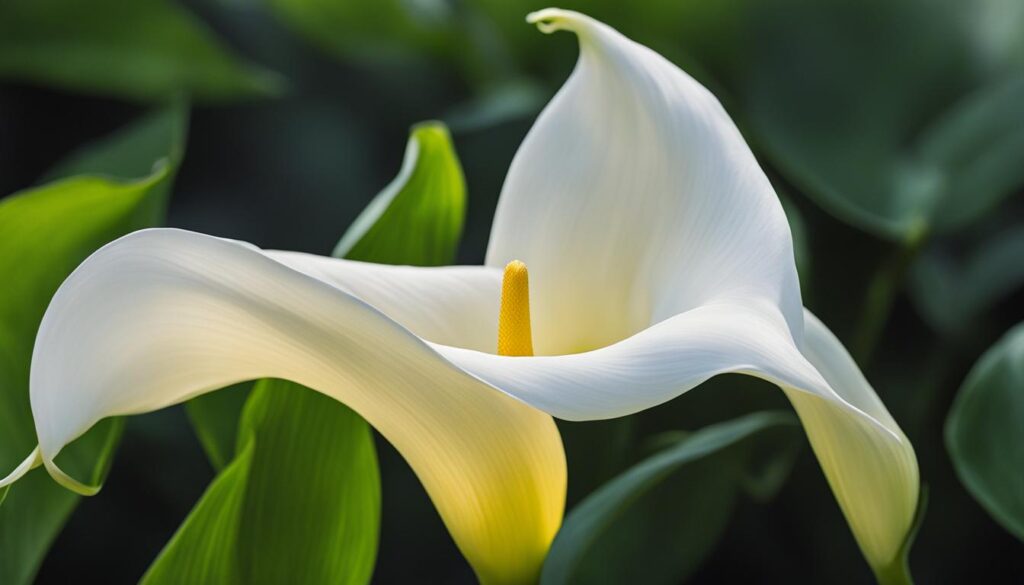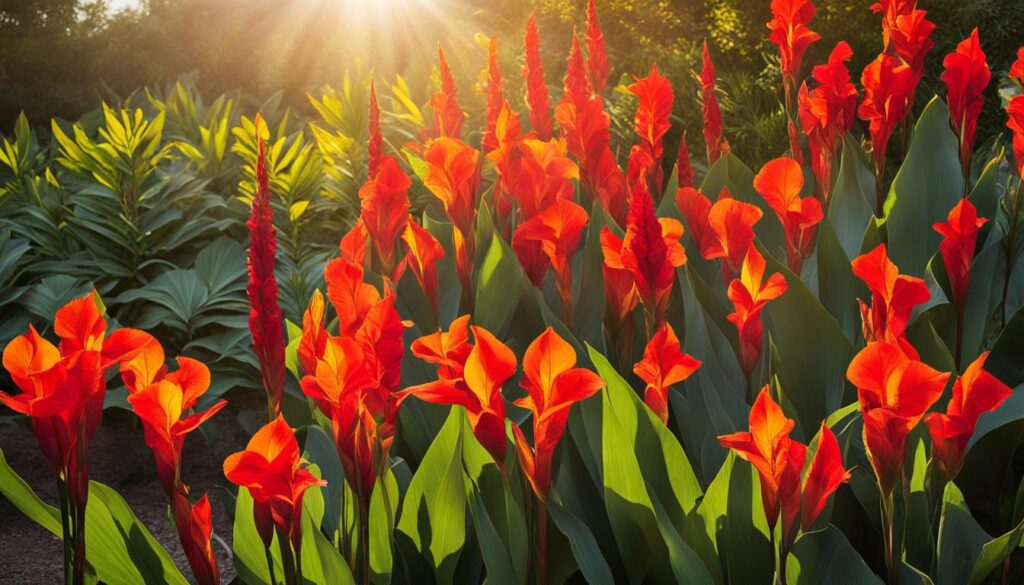Welcome to our friendly guide to understanding the differences between canna lilies and calla lilies. Whether you’re a seasoned gardener or just starting out, it’s important to know the unique characteristics and care requirements of these stunning flowers. Let’s explore the world of canna lilies and calla lilies to help you make informed decisions for your garden.
Calla lilies are highly sought after for special occasion bouquets and home gardens. With their vibrant blooms in various colors and long-lasting cut flower qualities, they add elegance to any arrangement. Native to Africa and thriving in tropical climates, calla lilies can be invasive in certain regions. It’s important to note that all parts of the plant are toxic to humans and pets.
On the other hand, canna lilies are known for their dramatic foliage and midsummer flowers. While they may not have the same cut flower qualities as calla lilies, their stunning foliage makes them a captivating addition to any garden. Native to tropical and subtropical regions, canna lilies can be grown in USDA hardiness zones 8 to 11.
Now that we’ve introduced canna lilies and calla lilies, let’s explore their characteristics and care requirements in more detail.
Key Takeaways:
- Canna lilies are known for their dramatic foliage and midsummer flowers.
- Calla lilies are sought after for special occasion bouquets and home gardens.
- Calla lilies are toxic to humans and pets, while canna lilies are not.
- Both canna lilies and calla lilies can be propagated through dividing rhizomes.
- Understanding the unique characteristics and care requirements of each can help gardeners decide which fits their preferences and garden conditions.
Characteristics and Care Requirements of Calla Lilies
Calla lilies are known for their gracefully shaped flowers in various colors, including white, pink, coral, maroon, orange, and yellow. These rhizome plants can grow to a height of 2-3 feet and a width of 1-2 feet, making them a striking addition to any garden or floral arrangement.
For calla lilies to thrive, they require full or partial sun exposure and prefer moist, well-drained acidic soil. They are native to Africa and thrive in warm climates, making them hardy in zones 8 to 10. However, they can enter dormancy when temperatures drop below 50 degrees Fahrenheit.
Proper care of calla lilies involves providing them with warmth, light, and moisture. They should be watered once a week or more frequently in hot or drought-like conditions. Fertilization is important upon planting and should be done every spring to promote healthy growth and flowering.
When it comes to different cultivars of calla lilies, there are various colors and flower types available. This allows gardeners to add a touch of diversity and unique beauty to their landscapes. Pruning is not necessary, but removing wilted flower parts can help maintain the plant’s overall health and appearance. Calla lilies can be propagated through dividing their rhizomes or growing from seeds.
Growing and caring for calla lilies:
- Plant calla lilies in well-drained, acidic soil.
- Provide full or partial sun exposure, depending on the climate.
- Water regularly to maintain moisture in the soil, especially during hot conditions.
- Fertilize upon planting and in the spring to promote healthy growth and blooming.
- Remove wilted flower parts to maintain the plant’s appearance.
- In colder zones, overwinter calla lilies by digging up the rhizomes and storing them indoors.
- Be aware of potential pests and diseases, such as bacterial soft rot and botrytis.
Introduction to Canna Lilies
Canna lilies are known for their dramatic foliage and midsummer flowers. With their vibrant colors and unique form, they can truly add a touch of elegance and drama to any garden or container. Native to tropical and subtropical regions, canna lilies thrive in warm climates, making them a popular choice for gardeners looking to create a tropical oasis.
“Canna lilies are like an artist’s brush, painting your garden with their bold and striking leaves. Their large, paddle-shaped leaves come in shades of green, purple, and bronze, adding a stunning backdrop to the vibrant flowers they produce.”
Unlike calla lilies, which are primarily appreciated for their blooms, canna lilies are primarily grown for their foliage. However, they also produce beautiful flowers in midsummer, attracting hummingbirds with their vibrant colors. From crimson red to fiery orange, canna lilies offer a range of hues, allowing gardeners to create eye-catching displays.
Key points about canna lilies:
- Dramatic foliage and midsummer flowers
- Native to tropical and subtropical regions
- Thrive in warm climates
- Attract hummingbirds with vibrant flowers
- Available in various colors
- Easy to grow in gardens or containers
Growing Canna Lilies
When it comes to growing canna lilies, providing the right growing conditions is key. These striking plants thrive in full sun or partial shade, depending on your climate. It’s important to choose a location that offers well-drained soil to prevent waterlogging and root rot. Rich soil, ample water, and mulched roots will help canna lilies flourish in your garden.
To ensure the stability of your canna lilies, it’s recommended to provide support in the form of staking. This will help them withstand summer storms and keep them upright and beautiful. Remember, canna lilies are a cross between Oriental and trumpet lilies, resulting in large, scented flowers that make a stunning addition to any garden.
Canna lilies are generally easy to care for, but they can be susceptible to bacterial soft rot and fungal diseases such as botrytis. Additionally, pests like aphids, slugs, and spider mites may pose a threat to their growth. To protect your canna lilies, avoid overwatering and ensure they receive proper sunlight and adequate airflow.
Propagation of canna lilies can be done through dividing their rhizomes. As the plants mature, you can carefully divide the rhizomes and replant them in separate areas of your garden or share them with fellow garden enthusiasts. This can help expand your canna lily collection and create more stunning displays of color in your outdoor space.
Care and Maintenance of Calla Lilies
When it comes to caring for calla lilies, a sunny location is essential. These elegant flowers thrive in full sun, so make sure to choose a spot in your garden or patio where they can receive at least 6 hours of direct sunlight each day. This will help ensure strong growth and vibrant blooms.
Regular watering is also crucial for the health of your calla lilies. Keep the soil consistently moist, but be careful not to overwater as this can lead to root rot. Aim to water your calla lilies once a week, or more frequently during hot weather or if the top inch of soil feels dry to the touch.
To promote robust growth and blooming, it’s important to provide your calla lilies with occasional plant food. Apply a balanced fertilizer every 4-6 weeks during the growing season, following the package instructions for dosing. This will replenish the nutrients in the soil and help your calla lilies thrive.
As you enjoy the beauty of your calla lilies, keep an eye out for any wilted flower parts and remove them promptly. This will not only maintain the aesthetic appeal of your plants but also encourage continued flowering. Additionally, proper overwintering is necessary for calla lilies in colder zones. Dig up the rhizomes before the first frost and store them indoors in a cool, dry place until the following spring.
By following these care and maintenance tips, you can ensure that your calla lilies remain healthy and vibrant, adding a touch of elegance to your garden or floral arrangements. With their stunning blooms and easy-to-care-for nature, calla lilies are a wonderful choice for any gardener looking to create a captivating outdoor space.
Growing and Caring for Canna Lilies
When it comes to growing and caring for canna lilies, there are a few key things to keep in mind. First, it’s important to provide these plants with the right amount of sunlight. They thrive in full sun or partial shade, so make sure to choose a location that meets their light requirements.
In terms of soil, canna lilies prefer well-drained soil that is rich in organic matter. This will help ensure proper root development and overall plant health. As for watering, canna lilies need regular moisture, so make sure to water them regularly to keep the soil consistently moist. However, be careful not to overwater, as this can lead to root rot.
Another important aspect of caring for canna lilies is providing support. These plants can grow quite tall, reaching heights of 2-3 feet, so staking them can help prevent them from toppling over during summer storms. Additionally, it’s essential to be mindful of potential pest and disease issues. Aphids, slugs, and spider mites are common pests that can affect canna lilies, while bacterial soft rot and fungal diseases like botrytis can also be a concern. Regularly inspect your plants and take appropriate measures to prevent and control these issues.
Summary:
- Provide canna lilies with full sun or partial shade.
- Plant them in well-drained soil enriched with organic matter.
- Water regularly to maintain soil moisture, avoiding overwatering.
- Support tall canna lilies with stakes to prevent toppling.
- Monitor for pests like aphids, slugs, and spider mites.
- Prevent and control bacterial soft rot and fungal diseases.
“Canna lilies bring a touch of drama to your garden with their vibrant foliage and midsummer flowers. By following the proper care guidelines, you can enjoy their beauty and create an eye-catching display.”
Conclusion
Both canna lilies and calla lilies are stunning additions to any garden, each with their own unique qualities. Calla lilies are highly sought after for special occasions, thanks to their beautiful blooms and long-lasting cut flower qualities. On the other hand, canna lilies are known for their dramatic foliage and vibrant midsummer flowers, adding a touch of drama to any landscape.
When it comes to care, it is important to provide the right growing conditions for both types of lilies. Calla lilies require partial to full sun exposure and well-drained acidic soil. They should be watered regularly, and proper feeding is essential for promoting flowering. Meanwhile, canna lilies thrive in full sun or partial shade and prefer well-drained soil. Regular watering and providing support for the tall stems are important aspects of their care.
One important distinction between the two is their toxicity. Calla lilies are toxic to humans and pets, so caution should be exercised when handling them. On the other hand, canna lilies do not pose the same toxicity risk. Both lilies can be propagated through dividing their rhizomes, making it easy to expand your collection or share them with fellow gardening enthusiasts.
By understanding the unique characteristics and care requirements of canna lilies and calla lilies, you can make informed decisions about which one is best suited for your preferences and garden conditions. Whether you choose the elegance of calla lilies or the drama of canna lilies, these beautiful plants are sure to enhance the beauty of your outdoor space.
Do Canna Lilies and Calla Lilies Have Similar Blooming Patterns to African Violets?
Canna lilies and calla lilies have different blooming patterns compared to African violets. While African violets require the right conditions and care, canna and calla lilies have their own unique blooming cycles. If you’re looking for a guide to African violet blooming, these lilies have their own distinct requirements.
FAQ
What are the characteristics and care requirements of Calla Lilies?
Calla lilies are native to Africa and grow from a rhizome. They prefer warm environments, well-drained soil, and regular fertilization. They come in various colors and require adequate sunlight, moist soil, and protection from frost. All parts of the plant are toxic to humans and pets.
How do you grow Canna Lilies?
Canna lilies are native to tropical and subtropical regions. They thrive in full sun or partial shade and well-drained soil. They prefer rich soil, ample water, and mulched roots. Proper care includes staking for support, regular watering, and overwintering in colder zones.
What are the care and maintenance requirements for Calla Lilies?
Calla lilies should be grown in a sunny location with well-drained soil enriched with organic matter. They require regular watering, especially in hot conditions. Feeding upon planting and in the spring promotes flowering. Pruning is not necessary, but removing wilted flower parts can be done. Rhizomes need to be dug up and stored indoors in colder zones.
How do you grow and care for Canna Lilies?
Canna lilies can be grown in gardens or containers. They prefer full sun or partial shade and well-drained soil. Regular watering, support in the form of staking, and overwintering in colder zones are essential. They can be susceptible to bacterial soft rot and fungal diseases and may have pest issues such as aphids, slugs, and spider mites.
What are the differences between Canna Lilies and Calla Lilies?
Both canna lilies and calla lilies have distinct characteristics and care requirements. Calla lilies are toxic to humans and pets, while canna lilies are not. Calla lilies come in various colors and are sought after for special occasions. Canna lilies are primarily grown for their dramatic foliage and midsummer flowers. Understanding their unique qualities can help you decide which is best for your garden.












